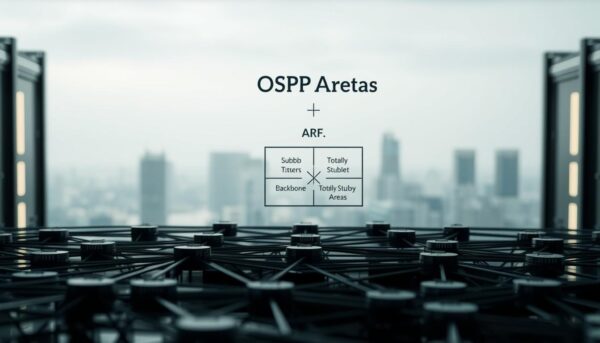✅ Last checked on
Ever wondered how data packets navigate the internet’s vast network? The secret lies in OSPF, a key routing protocol. But what makes OSPF unique in network communication?
Open Shortest Path First (OSPF) is a dynamic routing protocol at the heart of today’s networks. It’s the hidden hero that makes sure your data moves smoothly through complex networks. It adjusts to changes in real-time.
OSPF’s popularity is well-deserved. It’s supported by almost every router maker and the open-source community. This makes it a common language for network devices. It’s great for big networks, handling setups with over 1,000 routers in one area.
At its core, OSPF uses Dijkstra’s algorithm. This algorithm finds the shortest path for data to travel. It’s not just fast; it builds strong networks that can quickly change routes when needed.
Key Takeaways
- OSPF is widely supported across routing vendors
- It can manage networks with over 1,000 routers
- Uses Dijkstra’s algorithm for efficient path calculation
- Adapts quickly to network changes
- Essential for large-scale enterprise networks
- Provides real-time routing updates
Understanding the Fundamentals of OSPF
Open Shortest Path First (OSPF) is a key link-state protocol for big networks. It helps find the best paths for data in complex networks.
What is Open Shortest Path First Protocol
OSPF is a type of Interior Gateway Protocol (IGP). It uses cost to decide the best route. For instance, a 10 Mbps link costs 10, while a 100 Mbps link costs 1.
Key Components and Terminology
OSPF has a few main parts:
- Areas: These are logical parts of the network.
- Routers: These devices send packets between networks.
- Link-State Advertisements (LSAs): These messages share network info.
The protocol uses Dijkstra’s algorithm to find the shortest path. It keeps a database of links and uses the Shortest Path First (SPF) algorithm.
Evolution and Modern Applications
OSPF has been around for over 30 years. It has grown to handle big networks with ease. Each router finds the best path to every place in the network.

| OSPF Feature | Benefit |
|---|---|
| Area-based structure | Reduces routing info processing |
| Link-state updates | Provides quick recovery |
| Cost-based metric | Helps pick the most efficient path |
Network Architecture and Area Design
OSPF network topology uses a structured area architecture. This design makes large networks more efficient and scalable. Let’s look at the key parts of OSPF area design and their roles in a strong network structure.
Backbone Area (Area 0) Implementation
The backbone area, Area 0, is at the heart of OSPF networks. It’s the central hub for communication between areas. All other areas must connect to Area 0, either directly or through virtual links. This setup ensures efficient routing and prevents network splits.

Multi-Area OSPF Design
Multi-area OSPF breaks down the autonomous system into smaller units. This makes networks more manageable and improves performance. Each area has its own database, leading to faster recovery and better use of resources.
Router Types and Their Roles
OSPF networks use different router types, each with its own role:
- Internal Routers: Work within one area
- Area Border Routers (ABRs): Link multiple areas
- Backbone Routers: Sit in Area 0
- Autonomous System Boundary Routers (ASBRs): Connect to outside networks
| Router Type | Primary Function | Location |
|---|---|---|
| Internal Router | Intra-area routing | Single area |
| Area Border Router | Inter-area routing | Multiple areas |
| Backbone Router | Core routing | Area 0 |
| AS Boundary Router | External routing | Area edge |
Knowing these components helps network admins design efficient OSPF networks. Proper area architecture and strategic router placement ensure top performance across the system.
OSPF Operations and Route Calculation
OSPF is a dynamic routing protocol that works well in networks. It uses the Shortest Path First (SPF) algorithm for finding the best routes. This makes it great for big networks with lots of routers and different layouts.
Dijkstra’s Algorithm in Action
Dijkstra’s algorithm is key to OSPF’s route finding. It finds the shortest path by looking at each route’s cost. OSPF routers use this to find the best way to reach other parts of the network.
The cost of a route in OSPF is figured out by a simple formula. It’s the reference bandwidth divided by the interface bandwidth.
Link-State Database Management
OSPF keeps its network map up to date by managing its link-state database. This involves sending out LSA propagation across the network. OSPF updates its database every 1800 seconds.
Cost Metrics and Path Selection
When choosing paths, OSPF looks at cost metrics. The default bandwidth for OSPF is 100 Mbps. The highest link-cost is 65,535.
OSPF has a clear order for choosing routes:
- Intra-area routes (O)
- Inter-area routes (O IA)
- External routes type 1 (O E1)
- External routes type 2 (O E2)
This order helps OSPF make smart routing choices. It considers link bandwidth and other factors. This makes OSPF good at handling complex networks.
Interface Types and Neighbor Relationships
OSPF, a link-state protocol, supports different interface types. These types shape how networks connect and how routers talk to each other. The main types are broadcast and point-to-point interfaces.
Broadcast interfaces are like Ethernet, connecting many routers to one network. Point-to-point interfaces, on the other hand, connect directly to one OSPF router, like WAN connections.
On broadcast networks, OSPF routers use multicast to talk to each other. They choose a Designated Router (DR) and a Backup Designated Router (BDR) to manage updates. Point-to-point links are simpler, without this need.
Both types use a 10-second hello timer and a 40-second dead timer by default.
Neighbor relationships in OSPF go through several states. It begins with the Down state and moves to Init and 2-Way as routers exchange hellos. Then, it goes to Exstart, Exchange, and Loading as they share link-state information.
When routers have the same database, they reach the Full state. This means they are fully connected and synchronized.
Knowing about these interface types and neighbor processes is key for OSPF to work well. They affect how your network is set up and how it shares routing information. This ensures packets move efficiently through your network.
Implementation and Configuration Best Practices
Setting up OSPF, a dynamic routing protocol, needs careful planning. This section will guide you through key steps to configure OSPF in your network.
Basic OSPF Configuration Steps
To begin, enable OSPF on your router and assign a unique Router ID. This ID is what identifies your router in the OSPF domain. Then, define the networks you want to advertise using network statements. Remember, OSPF works within a single autonomous system, so plan your area design well.
Here’s a basic OSPF configuration example:
| Command | Purpose |
|---|---|
| router ospf 1 | Enable OSPF process |
| router-id 1.1.1.1 | Set Router ID |
| network 192.168.1.0 0.0.0.255 area 0 | Advertise network in Area 0 |
Optimizing OSPF Performance
To boost OSPF performance, tweak default timers and add security like MD5 authentication. For big networks, automation is key for managing OSPF configs and avoiding mistakes. Proper OSPF configuration makes your network maintainable and scalable.
Troubleshooting Common Issues
For troubleshooting, use “show ip ospf neighbor” to see OSPF neighbors and their status. The “show ip route ospf” command shows routes in the forwarding database via OSPF. These tools help spot and fix OSPF problems, ensuring your routing protocol works well.
Conclusion
OSPF is a strong and flexible routing protocol used in today’s networks. It works well with both IPv4 and IPv6 networks. It also supports advanced features like Variable Length Subnet Masking and route summarization.
This makes OSPF perfect for big enterprise networks. The protocol is quick to adapt to network changes. It has a hello interval of 10 seconds and a dead timer of 40 seconds.
OSPF’s administrative distance is 110, and its protocol number is 89. This balance helps make better routing decisions. It’s also scalable, supporting unlimited hop counts and dividing networks into areas.
The backbone area (Area 0) is key for managing large networks. While OSPF needs more CPU and RAM, its benefits are worth it. It improves network stability and traffic flow.
Exploring OSPF further, you’ll see it’s adaptable to many network types. It uses Dijkstra’s algorithm for finding the best paths. OSPF’s open-standard nature means it works well with different vendors, making it a smart choice for your network’s future.